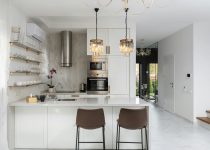What Considerations Matter for Wet-Area Landscape Lighting?
When planning wet-area landscape lighting, you need to consider several important factors to ensure both safety and aesthetics. From selecting the right fixtures to understanding local codes, each decision plays a crucial role. You'll want to think about moisture resistance, placement, and energy efficiency as well. How you approach these elements can significantly impact the overall effectiveness of your lighting design. Let's explore what you should keep in mind for a successful outcome.
Table of Contents
Key Takeaways
- Ensure fixtures are moisture-resistant with high IP ratings to withstand exposure to water and humidity.
- Prioritize electrical safety by using GFCI outlets and weatherproof enclosures to prevent shock hazards.
- Consider fixture placement to enhance visibility while minimizing glare and creating a pleasant ambiance.
- Opt for energy-efficient lighting solutions, such as LEDs or solar-powered options, to reduce power consumption.
- Regularly test and maintain lighting systems to ensure functionality and compliance with local safety codes.
Understanding Wet-Area Lighting Requirements
When you're planning your wet-area landscape lighting, it's crucial to understand the specific requirements that come with these environments.
First, you need to consider moisture exposure. Wet areas, like pools or gardens, require lighting that can withstand humidity, splashes, and even submersion.
Next, think about safety; ensure that your lighting solutions comply with local codes to prevent electrical hazards.
You should also account for the brightness and color temperature of the lights, as these factors can dramatically impact the ambiance.
Lastly, consider the placement of your fixtures. Proper positioning will enhance visibility while minimizing glare.
Selecting Moisture-Resistant Fixtures
When choosing fixtures for wet areas, you need to consider the materials' durability and resistance to moisture.
Look for products with a high IP rating to ensure they can withstand exposure to water and humidity.
This not only enhances safety but also prolongs the lifespan of your lighting.
Fixture Material Durability
Choosing the right materials for your landscape lighting is crucial, especially in wet areas where moisture can take a toll on fixtures.
You'll want to opt for materials that withstand harsh conditions, such as corrosion-resistant metals like stainless steel or aluminum. These options not only resist rust but also maintain their appearance over time.
Additionally, consider high-quality plastics or composite materials designed for outdoor use. They can offer excellent durability against moisture and UV rays.
Avoid using standard materials that may degrade quickly, leading to frequent replacements. Investing in moisture-resistant fixtures ensures longevity and reduces maintenance efforts, allowing you to enjoy your beautifully lit wet area without constant worry about fixture performance.
IP Rating Importance
Understanding the importance of IP ratings can significantly impact your selection of moisture-resistant fixtures. The Ingress Protection (IP) rating indicates how well a fixture can withstand water and dust.
For wet-area landscapes, look for fixtures with a minimum rating of IP65, which offers protection against water jets. This ensures your lighting can handle splashes, rain, or even sprinkler systems.
When you're choosing fixtures, pay close attention to their IP ratings to prevent damage and increase longevity. A higher rating means better protection; for instance, IP67 fixtures can even withstand temporary immersion in water.
Prioritizing moisture-resistant fixtures with appropriate IP ratings helps you avoid frequent replacements and ensures your outdoor spaces remain beautifully lit and safe.
Electrical Safety Considerations
When you're working with landscape lighting in wet areas, electrical safety is crucial.
You need to ensure that you have ground fault protection and use waterproof fixtures to prevent hazards.
Ground Fault Protection
To ensure safety in wet-area landscape lighting, ground fault protection is essential. This protection helps prevent electrical shocks by automatically shutting off power when it detects an imbalance in the electrical current.
When planning your outdoor lighting, consider the following:
- GFCI outlets that cut power quickly when a fault is detected
- Weatherproof enclosures that keep electrical components safe from moisture
- Regular testing of ground fault circuit interrupters to ensure functionality
- Proper grounding techniques to minimize shock hazards
- Clear signage to warn of wet areas around electrical installations
Waterproof Fixtures Required
Ground fault protection is just one part of ensuring safety in wet-area landscape lighting; using waterproof fixtures is equally important.
When you're selecting lighting for areas exposed to moisture, look for fixtures specifically designed to withstand water. These fixtures usually come with IP ratings that indicate their level of protection against water infiltration. Choosing options rated IP65 or higher ensures they're safeguarded against water jets and dust.
Remember, using standard fixtures in these environments can lead to electrical failures or hazards. By investing in waterproof fixtures, you not only enhance safety but also prolong the life of your lighting installations.
Make sure your outdoor spaces shine brightly and safely, even in wet conditions.
Placement and Design Strategies
While planning your wet-area landscape lighting, consider how placement and design can enhance both safety and aesthetics.
Strategic lighting can prevent accidents while showcasing the beauty of your outdoor space.
- Illuminate pathways with soft, warm lights to guide the way.
- Highlight water features, like fountains, with spotlights for a stunning effect.
- Use underwater lights to create a magical glow in ponds or pools.
- Position fixtures to cast gentle shadows, enhancing the texture of plants.
- Incorporate wall-mounted lights near seating areas for added ambiance.
Energy Efficiency and Sustainability
As you explore lighting options for wet areas, prioritizing energy efficiency and sustainability can significantly reduce your environmental footprint and energy costs.
Choose LED fixtures over traditional bulbs; they consume less power and last much longer. Look for products with high energy ratings, as these indicate better efficiency.
You might also consider solar-powered lights, which harness sunlight to operate, saving you money on electricity while being eco-friendly.
Additionally, using timers and motion sensors helps optimize energy use by ensuring lights only operate when needed.
By integrating these practices, you can create an inviting atmosphere in your wet areas while being kind to the planet.
Maintenance and Long-Term Care
Choosing energy-efficient lighting is just the first step in ensuring your wet-area landscape remains beautiful and functional.
To keep your lighting in top shape, regular maintenance is essential. Here are some key tasks to include in your routine:
- Inspect fixtures for signs of corrosion or damage.
- Clean lenses and bulbs to maximize brightness and clarity.
- Check electrical connections to prevent malfunctions.
- Trim surrounding vegetation to ensure effective light reach.
- Replace worn-out components promptly to maintain safety and aesthetics.
Frequently Asked Questions
What Types of Bulbs Are Best for Wet-Area Lighting?
For wet-area lighting, you'll want to choose LED or halogen bulbs that are waterproof and durable. They provide bright illumination while resisting moisture, ensuring safety and longevity in your outdoor spaces.
Can I Use Regular Extension Cords in Wet Areas?
You shouldn't use regular extension cords in wet areas. They're not designed for moisture exposure and can pose serious electrical hazards. Instead, opt for outdoor-rated extension cords that are specifically made for damp environments.
How Do I Know if My Fixtures Are Truly Waterproof?
To determine if your fixtures are truly waterproof, check their IP rating. Look for fixtures with an IP65 rating or higher, indicating they're protected against water jets and dust. Always read the manufacturer's specifications for assurance.
Are There Specific Plants That Should Avoid Direct Lighting?
Yes, some plants, like ferns and shade-loving varieties, shouldn't get direct lighting. You'll want to position your fixtures carefully, ensuring the light enhances your garden without damaging sensitive plants or disrupting their natural growth patterns.
What Local Regulations Should I Consider for Wet-Area Lighting?
You should check your local regulations regarding wet-area lighting, including safety codes, energy efficiency standards, and environmental impact guidelines. It's crucial to comply with these rules to ensure safe and effective outdoor lighting installations.



